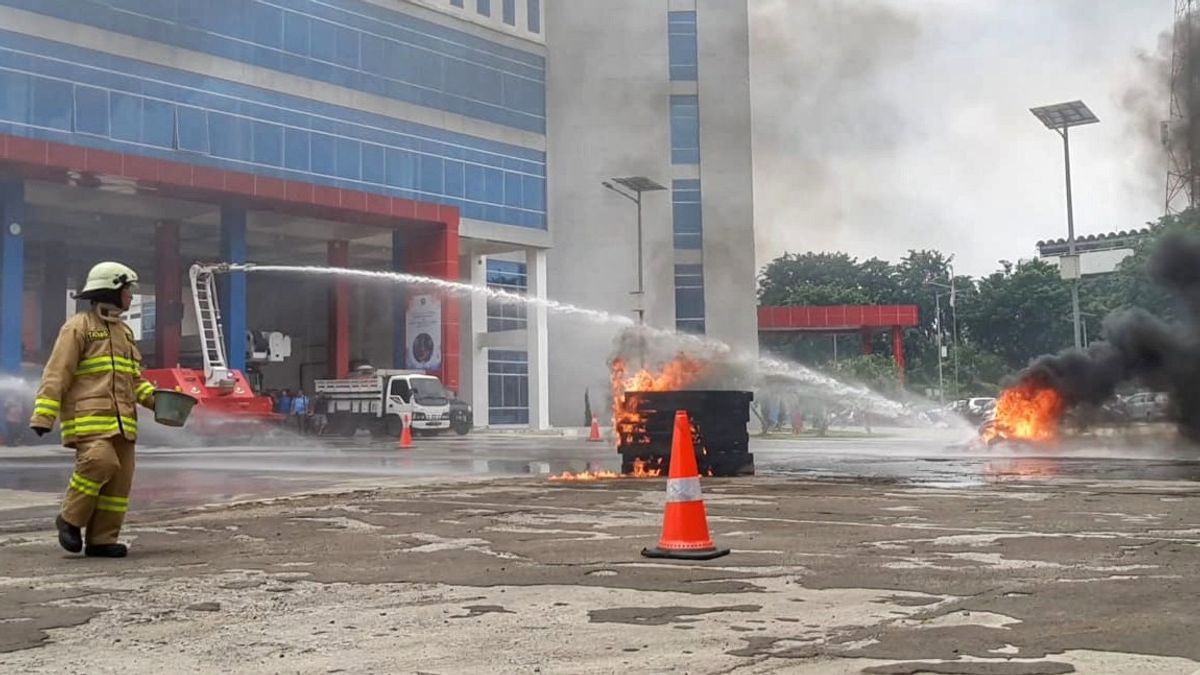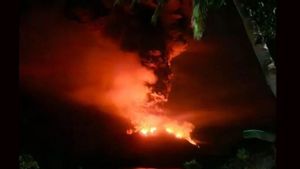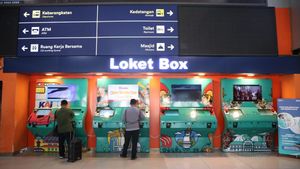
JAKARTA - "Don't send a man to do a machine's job". Agent Smith's famous quote in the film The Matrix is emblazoned on the body of a fire fighting robot belonging to the Jakarta Fire and Rescue Service (Gulkarmat). Some time ago, we had the opportunity to see the Dok-Ing MVF-U3 type fire decomposition machine working.
From the looks of it, the red robot's posture is not as big as other tools commonly used by firefighters. However, different things appear on the robot wheel because it uses a chain wheel like a tank.
The simulation in front of the Central Jakarta Gulkarmat office yard began when one of the four firefighters started operating the robot with a red remote in his hand. The authority to control the robot is not arbitrary. Only licensed personnel are permitted.
From that scene we realized Agent Smith's quote on the body of the robot made sense. Officers do not need to bet their lives to come to the fire point to decompose the fire material. Let the robot do it.
The robot's red remote controller looked like a miniature racing car. There are two analogues that function as steering mounted on the right and left of the remote. In the middle, there is a screen containing information regarding the speed and operating conditions of the robot.

The simulation starts
[Click to Taste]
The noise was deafening as the robot's chain wheels rubbed against the metal of the transport truck. The 2.5 meter high, three meter long and two meter wide robot began to move down to touch the ground at low speed.
The shape of the fire fighting robot became clearer. At the top was a sprinkler of water shaking with movement. The intense shaking led us to inquire about whether a machine or construction error had caused the violent shock of the sprinkler.
Next, the operator shows off the maneuverability of the extinguishing robot. From what we can see, the maneuvers are going well. The movement of the extinguisher robot looks dynamic when turning. Limited by several traffic cones that are installed every six meters, the robot is able to pass through the gaps between the traffic cones with curves.

Not enough maneuvers. Of course, the extinguisher robot must be able to deal with fire. A firefighter then carried some tires into the middle of the field. The tires are doused with kerosene before igniting them. Thick smoke rose high into the air.
Time for the fire fighting robots to roll. The first step in a standard operating procedure (SOP) is to ensure the availability of water in the tank. The availability of water can be monitored via an indicator on the remote control. Once confirmed, the robot moves closer to the fire point.
Jets of water were seen showering the flames. The water splashes on us who are standing around the action. No problem. In the middle of very hot weather, splashing water is enough.

Question
After all the attractions on display, a number of questions arose. For example, a water sprinkler that shakes violently due to a robot movement, for example. Head of DKI Gulkarmat Agency, Satriadi Gunawan, explained that there was no mistake in the construction of the assembly or anything.
"It's true. It's impossible to be rigid, it must be flexible (the spraying device). (The shock) has been thought about, it won't interfere with operations," said Satriadi at the location, Thursday, February 13.
In the simulation, the robot managed to extinguish the fire in a matter of minutes. Fast. The question is, what if the fire broke out in real life outside the simulation. According to Satriadi, the robot's capacity of 2,500 liters of water and 500 liters of foam is the answer to these doubts.
In addition to water capacity, the fire fighting robot also has a pump capable of pressing water above 15 bar. This means that the water sprinkler is capable of spraying at least 55 meters of pure water or 45 meters with a foam mixture.
This robot car is equipped with a clamp device and a load pulling device on the front. If at the fire site there are obstacles with objects weighing up to eight tons, they can be pulled out of the fire area or moved to a safer place.
Later, the fire fighting robot unit will be placed in fire brigade offices near the LRT and MRT facilities. According to Satriadi, the procurement of firefighting robots is the answer to the development of public facilities in Jakarta.

"You have to have this tool. Because of the challenges ahead. MRT, LRT is the answer. If a disaster occurs, we have equipment that is qualified. And this is one of the requirements as well. Requirements for countries that have MRT and LRT must have. fire handling facilities like ours, "said Satriadi.
Satriadi better be right. This is because the Dok-Ing MVF-U3 extinguisher robot was purchased from a producer from Croatia at a price of Rp. 32 billion. In addition to the Dok-Ing MVF-U3 robot, the authorities also brought in another robot called the LUF 60 which functions as a smoke sucker. The price is not arbitrary. Imported from Russia, the LUF 60 costs IDR 8 billion.
"So, we have a contract, we have a guarantee including a spare part guarantee. The spare spare part is already in a container prepared in Ciracas. This reserve is used when there is a problem. The 12 people include being educated on the mechanics, the electricity, including the operational one. It has all been covered by Croatia, "concluded Satriadi.
The English, Chinese, Japanese, Arabic, and French versions are automatically generated by the AI. So there may still be inaccuracies in translating, please always see Indonesian as our main language. (system supported by DigitalSiber.id)












